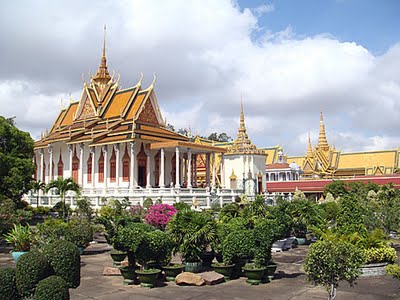Wat Preah Keo Morokat
 Looking at the Silver Pagoda from the southeast, you can see the spires rising from the Royal Palace are behind
Looking at the Silver Pagoda from the southeast, you can see the spires rising from the Royal Palace are behindLabels: Phnom Penh, Silver Pagoda
Cambodia - Temples, Books, Films and ruminations...
 Looking at the Silver Pagoda from the southeast, you can see the spires rising from the Royal Palace are behind
Looking at the Silver Pagoda from the southeast, you can see the spires rising from the Royal Palace are behindLabels: Phnom Penh, Silver Pagoda
Labels: Phnom Penh
Labels: Phnom Penh, Pont de Verneville, Tuol Sleng
Labels: Phnom Penh, Pochentong
Bonanza Three, anchored in the oily waters of Saigon harbour, seemed an ugly, rusty old tub, fit for the scrapyard, and that was the reason why she had been chosen for the Mekong River run: her owner thought her expendable. Happily for him, the American government is committed to Phnom Penh’s survival and, so far at least, it has always made it worth his while to gamble the ship and the lives of his crew for a quick return. “The risks are high, but generally so are the profits,” explained Johnny Khoo, manager of the Singapore-based shipping company that runs her. It is understood that profits fluctuate around £17,000 a trip.
The big joke aboard Bonanza Three was the loo. Apart from making privacy a farce, fist-sized shrapnel holes in the door and wall made it all too obvious that the consequences of using it at the wrong moment could prove disastrous. Happily, the Khmer Rouge gunners, notoriously bad shots, have never caught anyone with their pants down. The ship’s radio officer, I was told, was “absent”. Only later did I discover that the poor fellow had been killed two months before, blasted in his cabin by a rocket. Members of the crew had scooped up the pieces in a plastic bag and are still trying to erase this from their memories.
The convoy passed the first big danger point almost unchallenged. At Peam Chor, 15 miles beyond the frontier, the Mekong suddenly curves and narrows to a 500-yard channel – an ideal and frequent ambush spot. Conspicuous to our straining eyes were the hulks of two ammunition barges sunk 10 days before, during the last run. All that remained were pieces of rusty machinery poking from the sluggish water. With the sleepy little town of Neak Leung just a fading smudge to stern, the danger seemed over. Even Captain Pentoh relaxed, unzipping his flak jacket and pulling off his helmet, for he knew that no convoy had been hit on the home run for nearly a year. The ambush came quickly, with a rocket attack on the lead ship, the Monte Cristo, as she steamed past the Dey Do plywood factory only 12 miles from Phnom Penh.
From the wheelhouse on Bonanza Three, two ships astern, it was impossible to assess the damage, but flames and a feather of black smoke on the Wing Pengh, the ship 300 yards from our bows, denoted that she, too, had been hit. Machine-gun bullets clanged and rattled off the hull. In the wheelhouse, the little Cambodian pilot carried on with his instructions, his voice as steady as a rock, his fear betrayed only by his delicate fingers tightly wrapped round a small ivory Buddha. The words “starboard easy” had just left his lips when the rocket burst aft. The explosion felt like a heavy blow in the back. Nobody moved or said anything, except the captain, who said, “Bloody hell, we’ve been hit”, then looked around embarrassed.
Nobody bothered to leave the wheelhouse and inspect the damage until we were safely tied up at Phnom Penh’s dirty brown waterfront an hour or so later. The rocket had missed the steering column by a fraction of an inch; had it hit, Bonanza Three would have been sent circling out of control. A winch was badly damaged and there were a lot of holes, but she had survived yet another Mekong River run. Pinned to a blackboard in the press briefing centre in Phnom Penh that evening, the Cambodian high command’s communiqué tersely read: “A convoy of five cargo ships, two petrol tankers and three ammunition barges has anchored at the port of Phnom Penh after passing up the Mekong without incident.”
The Khmer Rouge captured Phnom Penh in 1975. Millions of Cambodians died in the “killing fields” massacres that followed.
Labels: Jon Swain, Khmer Rouge, Phnom Penh